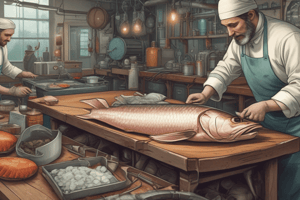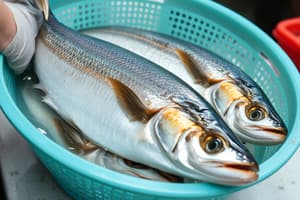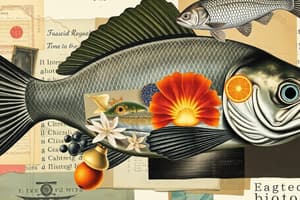Podcast
Questions and Answers
Which of the following pairs correctly matches a major fishery product with its local name?
Which of the following pairs correctly matches a major fishery product with its local name?
- Yellow fin tuna - Tulingan
- Indian Sardine - Hasa-Hasa
- Big Eye Scad - Galunggong (correct)
- Short Bodied Mackerel - Albacora
Which characteristic is shared among shrimps, prawns, crabs, and lobsters?
Which characteristic is shared among shrimps, prawns, crabs, and lobsters?
- They belong to the Thallophytes group.
- They have a short abdominal folded underneath the body.
- They possess a carapace joined to thoracic segments. (correct)
- They have a long abdomen compressed from top to bottom.
Which of the following statements accurately describes the difference between univalve and bivalve mollusks?
Which of the following statements accurately describes the difference between univalve and bivalve mollusks?
- Univalves are harvested by dredging, while bivalves are not.
- Univalves have two shells, while bivalves have one shell.
- Univalves are bilaterally symmetrical, while bivalves are asymmetrical.
- Univalves have one shell, while bivalves have two shells. (correct)
Which of the following is a primary application of seaweeds derived AGAR?
Which of the following is a primary application of seaweeds derived AGAR?
How does a starfish detect light despite lacking eyes?
How does a starfish detect light despite lacking eyes?
What distinguishes brittle stars from other echinoderms like starfish or sea urchins?
What distinguishes brittle stars from other echinoderms like starfish or sea urchins?
Which sponge type is both soft/absorbent and known for growing to a large size, potentially reaching 18 inches in diameter?
Which sponge type is both soft/absorbent and known for growing to a large size, potentially reaching 18 inches in diameter?
What is a unique characteristic of coelenterates regarding waste excretion?
What is a unique characteristic of coelenterates regarding waste excretion?
What adaptation allows squid to swim effectively in the ocean environment?
What adaptation allows squid to swim effectively in the ocean environment?
Why are corals often referred to as the 'medicine cabinets of the 21st century'?
Why are corals often referred to as the 'medicine cabinets of the 21st century'?
Which of the following characteristics helps classify algae as thallophytes?
Which of the following characteristics helps classify algae as thallophytes?
Which feature of crustaceans distinguishes them as belonging to the Decapoda group?
Which feature of crustaceans distinguishes them as belonging to the Decapoda group?
What is the primary method for harvesting univalve mollusks?
What is the primary method for harvesting univalve mollusks?
Which industrial application is most associated with sponges?
Which industrial application is most associated with sponges?
What is the defining characteristic of bivalve shellfish?
What is the defining characteristic of bivalve shellfish?
Compared to bath sponges, what is a distinctive characteristic of grass sponges?
Compared to bath sponges, what is a distinctive characteristic of grass sponges?
What role do zooplankton play in the diet of jellyfish?
What role do zooplankton play in the diet of jellyfish?
Why are brittle stars generally not consumed by humans?
Why are brittle stars generally not consumed by humans?
What adaptation allows Sea Cucumbers to gather food from the water?
What adaptation allows Sea Cucumbers to gather food from the water?
In which marine environment are sea anemones typically found?
In which marine environment are sea anemones typically found?
Which characteristic is associated with shellfish?
Which characteristic is associated with shellfish?
What distinguishes Echinoderms from other marine animals?
What distinguishes Echinoderms from other marine animals?
What is the purpose of calcareous supporting elements called ossicles in sea cucumbers?
What is the purpose of calcareous supporting elements called ossicles in sea cucumbers?
What commercial application do sea urchins have in the Philippines?
What commercial application do sea urchins have in the Philippines?
What's a key characteristic of Poriferans?
What's a key characteristic of Poriferans?
Which seaweed extract is primarily used in stabilizing ice cream and producing chocolate milk?
Which seaweed extract is primarily used in stabilizing ice cream and producing chocolate milk?
What do mussels, pens, scallops, and clams have in common that classifies them together?
What do mussels, pens, scallops, and clams have in common that classifies them together?
Which of the following describes the genus of seaweeds that are most commonly exported?
Which of the following describes the genus of seaweeds that are most commonly exported?
What is the primary way that bivalve shellfish obtain their nutrition?
What is the primary way that bivalve shellfish obtain their nutrition?
Flashcards
Shrimps and Prawns
Shrimps and Prawns
Shrimps and prawns are crustaceans with a long abdomen and a body compressed from side to side.
Crabs
Crabs
Crabs are crustaceans with a short abdomen folded underneath the body, flattened, oval bodies covered with a carapace.
Lobsters
Lobsters
Lobsters are larger decapods with a long abdomen and a body compressed from top to bottom.
Mollusks
Mollusks
Signup and view all the flashcards
Univalve
Univalve
Signup and view all the flashcards
Bivalve
Bivalve
Signup and view all the flashcards
Squid, Cuttlefish, Octopus
Squid, Cuttlefish, Octopus
Signup and view all the flashcards
Thallophytes
Thallophytes
Signup and view all the flashcards
Blue-Green Algae
Blue-Green Algae
Signup and view all the flashcards
Green Algae
Green Algae
Signup and view all the flashcards
Echinoderms
Echinoderms
Signup and view all the flashcards
Sea Cucumber
Sea Cucumber
Signup and view all the flashcards
Sea Urchin
Sea Urchin
Signup and view all the flashcards
Poriferans
Poriferans
Signup and view all the flashcards
Coelenterates
Coelenterates
Signup and view all the flashcards
Study Notes
Fishery Resources
- Encompasses various marine and aquatic life harvested for commercial and subsistence purposes
Major Fishery Products
- Big Bodied round scad (galunggong)
- Indian sardine (tamban)
- Frigate tuna (tulingan)
- Long jawed anchovy (dilis)
- Slip mouth (sapsap)
- Yellow fin tuna (Albacora)
- Big eyed scad (matangbaka)
- Small mouth threadfin (mamaleng bato)
- Fimbriated herring (tunsoy)
- Short bodied mackerel (hasa-hasa)
Minor Fishery Products
- Crustaceans
- Mollusks
- Thallophytes
- Echinoderms
- Poriferans
- Coelenterates
Crustaceans
- Shrimps, prawns, crabs, and lobsters belong to this group
- They are part of the Decapoda order, meaning they have ten feet
- They have compound eyes and a carapace joined to their thoracic segments
Shrimps and Prawns
- Characterized by a long abdomen and a body compressed from side to side
Crabs
- Have a short abdomen folded underneath the body
- Their bodies are flattened, oval, and covered with a carapace
- They possess one pair of large anterior claws and four pairs of legs at the thorax
- The head features a segmented mouth, a pair of eyes on movable stalks, and two pairs of antennae
Lobsters
- Are larger decapods with a long abdomen and a body compressed from top to bottom
Mollusks
- Are abundant, colorful, beautiful, expensive, and varied animals in the ocean
- Includes shellfish, squid, and octopuses
Shellfish
- Are a subgroup of mollusks
Univalves
- Have one shell
- Are harvested through dredging
- Their shells can be crafted into items like necklaces, earrings, and home décor
Examples of Univalves
- Triton
- Helmet
- True Conch
- Moon Snail
- Cowrie
- Sundial
- Abalone
- Top shell
- Bubble
- Cone
- Olive
- Vase
- Murex
- Slit Shell
- Volute
- Turban
- Tun
- Frog shell
- Tulip
- Nutmeg
Bivalves
- Have two shells
- Are bilaterally symmetrical with a foot and two calcareous shells connected by strong adductor muscles
- If both shells are similar, they are equivalve, otherwise, they are inequivalve
- Equivalves: mussels, pens, scallops and clams
- Inequivalves: oyster, and windowpane (kapis)
- Bivalve shellfish burrow in the seabed and feed on phytoplankton and zooplankton
- They are harvested by dredging and digging
Examples of Bivalves
- Mussel
- Scallop
- Tellin Clam
- Giant Clam
- Lucine
- Cockle
- Pen
- Pearl Oyster
- Jackknife Clam
- Surf Clam
- Bittersweet
- Ark Shell
- Venus Clam
- Thorny Oyster
- Piddock
Squid, Cuttlefish, and Octopus
- Highly developed mollusks with prehensile tentacles surrounding their head and camera-type eyes
- Squid and cuttlefish have 10 tentacles and an internal shell
- Octopus lacks a shell and has eight tentacles
- Squid can swim actively using jet propulsion or fleshy fins
- They are carnivorous, preying on crustaceans, fish, and other mollusks
Thallophytes
- Algae are classified as thallophytes
- They're flowerless plants without true roots, stems, or leaves and are highly sea vegetables
- Grow in marine water and are called sea weeds
- Eucheuma, Glacilaria and Gelidiella are the genera of seaweeds exported.
Two Kinds of Algae
- Move freely
- Grow in a fixed location (commercial importance)
Algae Classification by Color
- Blue green (Cyanophytes) (FW)
- Green (Chlorophytes) (MW)
- Brown (Phaeophytes) (MW)
- Red (Rhodophytes) (MW)
Uses of Seaweeds
- Human and animal food
- Medicine
- Fertilizer
- Chemicals
- Good source of iodine
- Extract from Gracillaria & Gelideilla is used for suppositories and laxatives
Agar
- Bakery icing
- Bacteriological laboratory medium
- Medicinal suppositories/laxative
- Dental applications
- Industrial uses
Carrageenan
- Cocoa fiber
- Production of chocolate milk
- Stabilizing ice cream
Algin
- Food dressing
- Beverages
- Beer
Echinoderms
- Exhibit an apparent radial symmetry
- Have five equal rays
- Possess soft, leather-like body walls
- Tend to be firm and nearly immovable (sea urchin)
- Body walls often covered in knobs (starfish & brittle star)
- Equipped with a well-developed alimentary canal, providing both a mouth and anus
- Features a combined respiratory and locomotor system known as the water vascular system
Groups of Echinoderms
- Sea Cucumber
- Sea Urchin
- Starfish
- Brittle Star
Sea Cucumber
- Holothurian with a sausage-shaped, rubbery body lacking a bony skeleton and containing calcareous ossicles
- Has five oral feet modified into tentacles to ingest food
- Feeds on minute invertebrates, filtering them from the water
- Comes in various colors: brown, spotted brown, grayish, black
- Harvested through dredging during high tide or collected under stones, coral, and seaweed
- Considered a delicacy in the Orient, especially Japan and China, in soups and recipes
- Can be prepared into sitsaron or blended with pancit loglog
Sea Urchin
- Possesses unattached, disk-shaped shells, movable spines, and microscopic button-like bodies
- Has a complex chewing structure known as Aristotle's lantern with five conveying jaws and accessory ossicles
- Feeds on phytoplankton, zooplankton, and other waste materials
- Majority are dark purple, green with intense shades of red, orange, and some striped spines
- Sharp, shallow spines contain a toxic substance that are very painful when broken in the skin
- Thick gloves are recommended during gathering
- Sold in local markets in Mindanao
- Reproductive glands are salted for the market
- Shell of sand dollar used as paper weights
- Striped spines used for decoration and jewelry
Starfish
- Lack eyes but can detect light using photosensitive cells at the end of their ambulacral grooves
- Typically have five arms, although some species may have more
- Exhibit brilliant colors, including orange, brown, green, and violet
- Move along the seabed using tube feet
- Live at low tide and sometimes float on seaweed
- Can be picked up during low tide
- Used for decoration
- Seldom eaten due to bitter taste
Brittle Star
- Have five long, slender, brittle arms
- Have the least economic importance
- Not eaten due to their tough skeleton rather than toxicity; they are not dangerous or venomous
Poriferans
- Sponges
- Represent a minor fishery product
- Simplest of multi-celled animals
- Hermaphroditic, multiplying by fertilizing eggs
- Grow in groups with regeneration
- Vary in color: orange, brown, purple, ivory, white, yellow, black, or red
Marketable Sponges
- Wool Sponge
- Looks like inverted pineapple with a voluminous, regular form
- Soft, absorbent, and can grow up to 18 inches in diameter
- Bath Sponge
- Relatively large with a caked shape
- Less durable, less resilient and easily loses elasticity
- Grass Sponge
- Grows to the same size as wool and bath sponges
- Dirty brown, highly resilient, elastic, and softer in texture
- Yellow Sponge
- Attractive yellow or yellowish brown
- Most elastic and resilient, but less durable, less fine, and less absorbent than other commercial sponges
- Velvet Sponge
- Spherical, smooth, soft, fine, durable, and can absorb and retain large water volume
Uses of Sponges
- Decoration
- Bath and toilet purposes
- Pillows
- Furniture
- Cleaning records
- Washing dishes
- Mattresses
- Padding
- Washing vehicles
- Industrial purposes
- Bank tellers
- Jewelers
- Leather workers
Coelenterates
- Lack an anus; waste is expelled through the mouth
Three Classes:
- Hydrozoa
- Anthozoa
- Scyphozoa
Coelenterates Include:
- Corals
- Sea Anemones
- Jellyfish
Corals
- Reefs are considered medicine cabinets
- Reef plants and animals are sources of new medicines for cancer, arthritis, human bacterial infections, Alzheimer's, heart disease, viruses, and other illnesses
Sea Anemones
- Belong to class Anthozoa
- Flower-like polyps with cylindrical shape, mouth, and surrounding tentacles at one end
- Attached to rocks, piles, shells or hermit crabs
- Many species can grow up to 36 inches in diameter
- Distributed in Visayas & Sulu and used for decoration & jewelry
Jellyfish
- Scyphozoan
- Free-swimming with transparent, bell-shaped watery bodies, with tentacles projected
- Part of floating plankton due to slow movement and rhythmical muscular contraction
- Feed on zooplankton
Studying That Suits You
Use AI to generate personalized quizzes and flashcards to suit your learning preferences.




